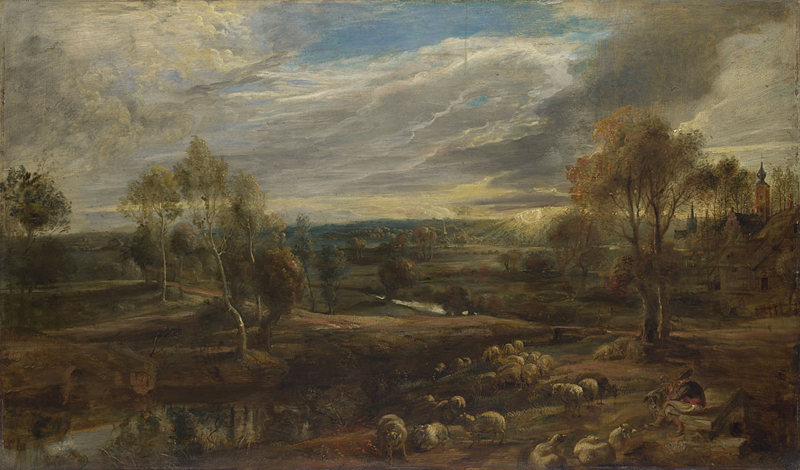By 1635, Peter Paul Rubens (1577–1640) just wanted to retire. His second wife was still in the bloom of youth at the age of 21, he was feeling the effects of his many years of hard work painting commissioned work, and was fast approaching sixty. He was rich enough to be able to buy himself a comfortable estate just to the south of Antwerp, and wanted a few years to enjoy life with his family, which continued to grow: his last child was born eight months after his death.
He couldn’t stop painting, though, and clearly kept himself busy in his studio there, producing some of the most wonderful works of his career – mainly landscapes. By a quirk of fate, of his six great late landscapes, four are within a couple of miles of one another in London. So the next time that you get the chance, you should be able to enjoy looking at those paintings over the course of a morning or afternoon.
Rubens had painted landscapes in the past, and counted among his close friends some of the greatest landscape painters of the day: the Brueghels (particularly Jan Brueghel the Elder) and Adam Elsheimer, for example. But now he was free to paint what he wanted, how he wanted. What he created was an important influence on future generations, including Thomas Gainsborough and British artists through John Constable.
Far from the pressures of commissions, and their patrons, Rubens was able to make careful observations of nature, the natural world, and some of the transient effects of light which are all too often taken for granted. He still painted these works in the studio, on sometimes quite substantial oak panels made for him through his Antwerp workshop, but based them on many superb drawings which he made in front of the motif. He even painted some studies in gouache.
Rubens assembled these details into carefully composed and somewhat idealised views. They are more true to a given location than, say, Poussin’s landscapes, but less than Constable’s.
Because they were not documented commissions, but private works, there remains considerable uncertainty of the dates of these paintings, but the six I show below are generally agreed as works painted between 1635 and Rubens’ death in 1640. In which order he painted them is a matter of speculation.

Evening Landscape with Timber Wagon (1635-40) is a smaller panel, now in Rotterdam, which reminds me of much later works by Gainsborough and even Constable. The sky is starting to grow dark, with a small pink glow from the setting sun, and birds are returning to their nests. A man drives his timber wagon down into a ford, as he grows near to home, and his evening meal.

An Autumn Landscape with a View of Het Steen in the Early Morning (c 1636) is one of the larger panels, now in The National Gallery in London, and one of my favourites. As the sun is rising off to the right, a man drives a cart, on top of which a woman is perched precariously, away from Ruben’s castellated mansion. Beside that stream, a hunter is stalking game with his gun and dog.
A small group of people are on the grass in front of the house: a woman is seated, perhaps nursing an infant; next to her is another woman, and a man. Another man is fishing in the moat, from the bridge which connects its main entrance with the outside world. At the far right, a milkmaid walks out to a small herd of cows.
There are birds in the sky, and some small tits and others on the scrub in the foreground. Beyond, a great plain of meadows and woods sweeps far to the horizon. The day has begun.

Landscape by Moonlight (1635-40) is a medium-size panel, now in The Courtauld Institute, London, and one of the most exciting of the group. I am sorry that the only available image does not do justice to this stunning nocturne, again set in the mixed pasture and woodland of the country near Antwerp.

Landscape with a Rainbow (c 1638) is another of the larger panels, in the The Wallace Collection in London. Here Rubens shows the countryside, and its people, at work. At the left, the harvest is in full swing, with haystacks being constructed. The wagoner passes by a couple of young women, one of whom is carrying a vessel on her head, and being propositioned by a man.
In the centre foreground, a small herd of cows are being controlled by their herdsman, while at the right is a gaggle of geese and ducks by the river. Above all this the sky is full of one of nature’s great spectacles: a rainbow, as a series of showers sweep across the gently rolling meadows and woods below.

Landscape with the Return from the Harvest (c 1637) is one of the larger panels, in the Palazzo Pitti in Florence. When this image was made it was in need of cleaning, but it shows another arrangement of country people on their way back after a hard day’s work at the harvest. There is again banter between the women and men.

A Landscape with a Shepherd and his Flock (c 1638) is a smaller panel, also in The National Gallery in London, showing a pastoral view perhaps at the back of Het Steen, as the sun is low in the sky.
What a wonderful way to end such an illustrious career: that’s what I call retirement.

